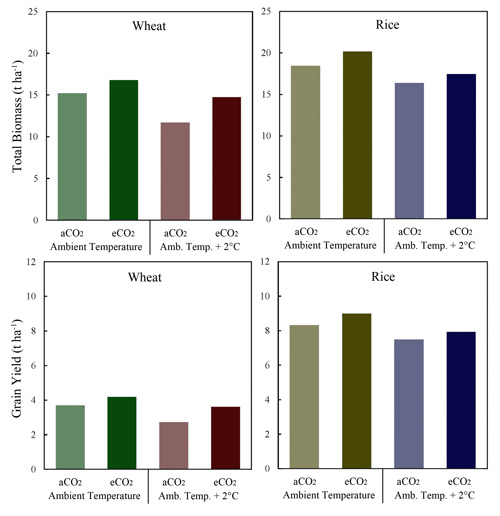| Follow @co2science |
Paper Reviewed
Wang, J., Liu, X., Zhang, X., Smith, P., Li, L., Filley, T.R., Cheng, K., Shen, M., He, Y. and Pan, G. 2016. Size and variability of crop productivity both impacted by CO2 enrichment and warming - A case study of 4 year field experiment in a Chinese paddy. Agriculture, Ecosystems and Environment 221: 40-49.
Providing the rationale for their study, Wang et al. (2016) write that few studies have focused on the interaction between atmospheric CO2 enrichment and warming on crop growth, such that the combined effects of these two important variables "are still not well understood." In an effort to advance our understanding in this area, the ten-member research team conducted an experiment examining the effects of these two variables on two important food crops: wheat and rice.
To do so, the authors used free-air CO2 enrichment (FACE) technology in a field setting located at Kangbo village (31.5°N, 120.55°E), Guli Township, Changshu municipality in Jiangsu Province, China, where they grew four experimental treatments of wheat (Triticum aestivum, cv. Yangmai No.14) and rice (Oryza sativa, cv. Changyou No.5) in rotation over a period of 4 consecutive years beginning in 2011. The four treatments included (1) ambient CO2 and ambient temperature, (2) elevated CO2 and ambient temperature, (3) ambient CO2 and elevated temperature and (4) elevated CO2 and elevated temperature, where ambient CO2 = 400 ppm, elevated CO2 = 500 ppm and elevated temperature = ambient temperature + 2°C. The results of their work are captured in the figure below.
In viewing the figure, it can be calculated that under ambient temperature, elevated CO2 increased the total biomass of wheat and rice by 10.5 and 9.5 percent, respectively, whereas under elevated temperature, it increased it by 25.5 and 6.7 percent. Similar improvements are noted for grain yield, which increased by 13.5 and 8 percent for wheat and rice, respectively, in the ambient temperature treatment and by 31 and 6 percent in the elevated temperature treatment. Thus, regardless of the temperature treatment (ambient or ambient + 2°C), elevated CO2 had a stimulatory effect on the biomass and grain yield of these two important crops.

Figure 1. Total biomass and grain yield (t ha-1) of wheat and rice crops averaged over four growing seasons (2011-2014) under two different CO2 concentrations (400 and 500 ppm, represented by aCO2 and eCO2, respectively) and temperature (Ambient and Ambient + 2°C) treatments. Adapted from Wang et al. (2016).




